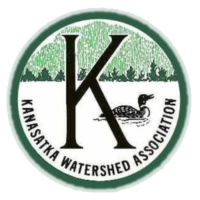What are Native Plants?
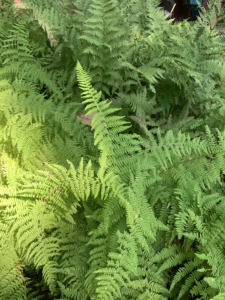
Dennstaedtia punctilobula (Eastern hay-scented fern). Credit: Judy Stoessel. Published with permission.
A plant, whether found on land or in the water, is considered native if it has occurred naturally in a particular region, ecosystem, or habitat without human introduction. These plants have evolved over thousands of years in a particular region and have adapted to the geography, hydrology, and climate of that region. They have close, symbiotic relationships with other flora and fauna, resulting in rich, biodiverse ecosystems.
All plants are native somewhere. The trick is to figure out the ones that are native to our region of New Hampshire. This can be confusing, because so many of the plants that are familiar to us and planted in our yards are non-native ornamentals promoted by the nursery trade or landscape contractors or reflective of our own aesthetic preferences. These non-natives may be beautiful, but they generally do not benefit the pollinators and other animals in the area.
Native plants can add great beauty to the landscape. Sometimes they are more understated than their hybridized or ornamental cousins, but with native plants you can generally choose to create a more formal or a more wild space with a variety of colors, textures, heights, bloom times and interest in all seasons, just as you can with the non-native ornamental plants so common in the nursery trade.
For further reading: What Are Native Plants?—Grow Native Massachusetts
Why are Native Plants Important?
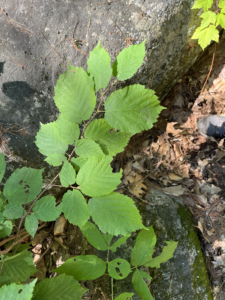
Corylus cornuta (Beaked hazelnut). Credit: Judy Stoessel. Published with permission.
It is important to place our local efforts on behalf of Lake Kanasatka within the larger context of declining biodiversity and climate change.
Native plants create a natural habitat for beneficial wildlife. Those of us who garden normally think of pollinators such as bees, birds, and butterflies, but native plants also help create homes for other insects and spiders, fish, amphibians, reptiles, mammals, and microscopic organisms. These living things each have important jobs and they have tightly symbiotic relationships.
According to the American Audubon Association, native plants provide nectar for pollinators including hummingbirds, native bees, butterflies, moths, and bats. They provide protective shelter for many mammals. The native nuts, seeds, and fruits produced by these plants offer essential foods for many forms of wildlife.
Native plants tend to be healthier and stronger than plants hybridized by the nursery industry. Plants native to an area are more likely to establish quickly and will be naturally hardy and healthy. Of key importance to the efforts to protect Lake Kanasatka, the root systems of native plants are deep, sometimes up to 15 feet, which can help to control shoreland erosion and prevent water run-off. In addition, once established, native plants require little to no watering, fertilizer, or pesticides.
Native plants tend to be low maintenance. This is important if you want to spend your time on recreation rather than yardwork! The American Society for Landscape Architects says that the long-term upkeep of native plants can be dramatically less costly than turf grass, as well as take less time.
Additional Resources on the Importance of Native Plants
Why Native Plants Matter—Wild Seed Project
The Benefits of Native Plants in Your Garden—Soak Up the Rain New Hampshire
Gardening for Life–Doug Tallamy
Ten Things to Get You Started—Home Grown National Park
Nature-Based Gardening—Perfect Earth Project (link is to download the pdf brochure)
Why You Should Grow Native Plants in Your Garden—Smithsonian Magazine
How Do I Identify Native Plants?
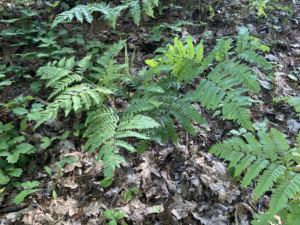
Pteridium aquilinum (Bracken fern) in a shorefront buffer. Credit: Judy Stoessel. Published with permission.
The first step is to identify the plants in your yard. Then you can look up information about whether they are native. The identification part is complicated, and you will have fun with it if you like doing research, are good at observing details, and like solving puzzles. A little bit of backyard botany may not be for everyone, but we need to start seeing the plants in our yard as individual entities, not just a collection of “green stuff”, “bushes” or “weeds.” It is only then that we can start to respect and understand the roles these plants play in our environment.
There are numerous print field guides that will help with plant ID. Peterson’s Field Guides, The Audubon Society Field Guides, and Taylor’s Guides all have numerous editions for trees, shrubs, and flowers. Be sure you are looking at a Northeast or New England edition. With any luck you may already know what a few plants are. Start with those and look up what you think they are to confirm your ID. Start and keep a list.
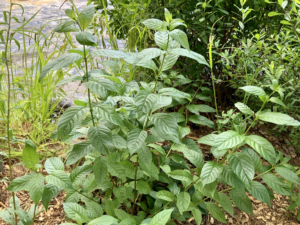
Cephalanthus occidentalis ( Buttonbush) at the water’s edge. Credit: Judy Stoessel. Published with permission.
As you do your research, you may be surprised at how many plants you already have in your yard that are NOT native. Many traditional ornamental landscaping plants including forsythia, lilac, rhododendrons, azaleas, hydrangeas, hostas and grass lawns are not native to New Hampshire or New England. There is still room for some of your favorite non-native ornamentals in your yard, but the recommended ratio is to aim for at least 70% native plants.
Plant reference books can be confusing, so your research can take a different route. Consider starting with a photo that you take with your phone and then use one or two of several applications that let you load that photo and generate an ID. Most of the apps have a free version. Consider using Picture This, Leafsnap, and PlantNet.
Study conducted by Michigan State University on the accuracy of various apps
Link to several recent ID app reviews
These apps are not always accurate, so it is a good idea to triangulate among several to see if you are getting a consistent answer. You can also use the “look up” feature on your cell phone or Google lens. On an iPhone, you can open a photo you have taken of a plant and click on the information button. There you can click on “look up plant.” As with the other apps, this can be a helpful but not fail safe tool.
Part of using the apps is deciding whether the ID makes sense. If you get an ID for a plant from Australia, it’s probably not correct! Sometimes the app just can’t read the photo you have provided. But if you start to get a consistent answer, then you can zero in with further research, either by using a field guide or by going online to find more details about the plant and to check your ID.
All the while as you research, you should be thinking about whether the attributes fit the plant you are looking at.
Sometimes it takes several seasons to figure it out. Bloom color is a clue, as are shape, size, type of bark, and what type of terrain the plant is thriving in. But sometimes even with all of that, you might not be able to confirm an ID until you also see the color of berries in the fall and the fall foliage color. If you want to be a real backyard botanist, you can get into more specific attributes like leaf shape, position of leaves on stems, and how the flowers are constructed.
Another tip is to try to learn and use the scientific names for the plants. Common names differ regionally and can create confusion when you go to look up further information.
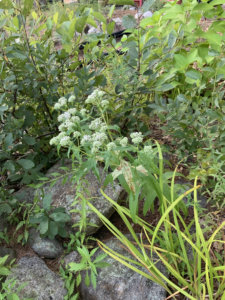
Eupatorium perfoliatum (Boneset) in a shorefront buffer. Credit: Judy Stoessel. Published with permission
How Do I Know if a Plant I Have Identified is Native?
Once you are fairly sure of your ID, the authoritative source for what is native to our area is the Native Plant Trust’s tool called Go-Botany.
The searchable database includes simple and full plant keys for identifying a species based on a variety of features, from growth form to flower shape to fruit type, with photos that document all of these features. Species pages include New England-centric distribution maps and valuable notes on common look-a-likes. There is an ‘Ask the Botanist’ portal for expert insight into your plant ID queries.
You can use this tool to “key out” the ID of a plant, and compare different plants from the same genus. But perhaps the most useful thing is the confirmation as to whether a plant is native to our area, and what its native range is.
Additional Resources About Plant Identification
Helpful Online Field Guides:
- A Field Guide to Common Aquatic and Riparian Plants of New Hampshire—New Hampshire Department of Environmental Services
- Aquatic Plants and Algae of New Hampshire’s Lakes and Ponds—New Hampshire Department of Environmental Services
- A Guide to the Trees, Shrubs and Woody Vines of New England—New England Trees
Good Online Sites for Further Information about Specific Plants:
Plant lookup by common or scientific name
This is a rich, interactive database with lots of photos and good information about native plants and ecoregions. You can look up plants by common or scientific name.
This searchable database helps with plant ID (both native and non-native) and also describes in detail the growing characteristics of each species. It focuses on plants used in horticulture, both native and non-native, and includes over 7,000 species. Uniquely, it has information on many popular cultivars, including about how they were originally propagated (i.e. the parentage of a hybrid plant), details which are often not readily available. Making it especially useful, each species page has a valuable in-depth description of the plant’s noteworthy characteristics, culture requirements, and suggestions for use in a landscape setting. In addition to searching for information by species, plant selection searches can be filtered using standard criteria like bloom time, maintenance needs, and moisture requirements.
